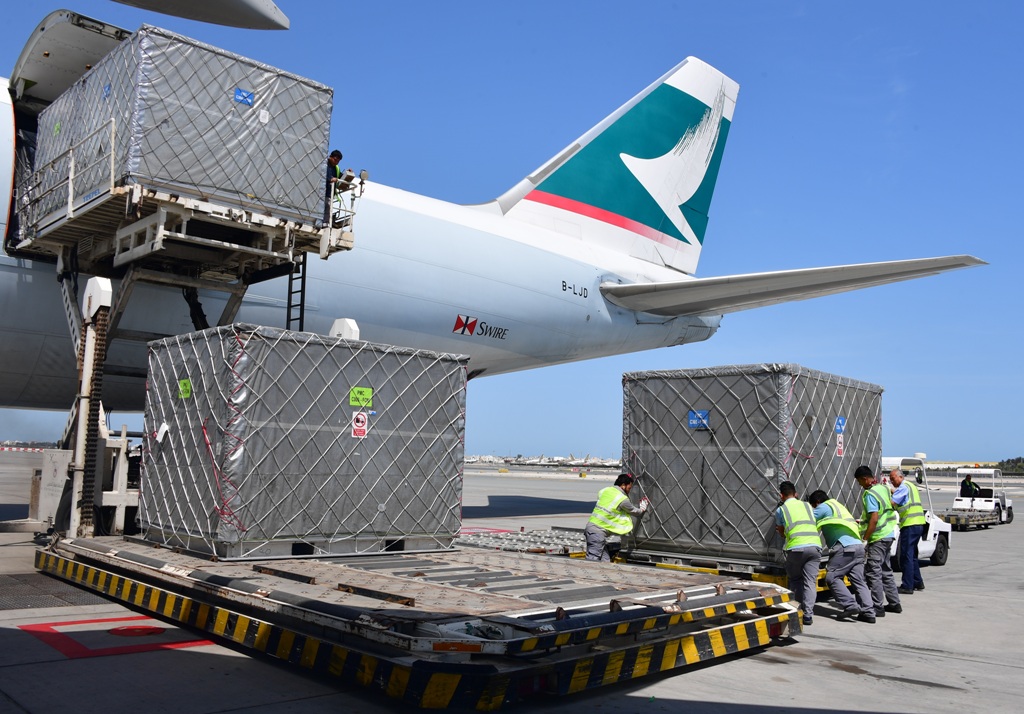Cathay Cargo: Developing and delivering the agenda
03 / 08 / 2021

Rajesh Menon, Cathay Pacific. Source: Cathay Pacific
Airfreight digitalisation and customer-centric products are top of the long-term strategic agenda for Cathay Pacific Cargo as it navigates the pandemic with a focus on vaccine distribution and e-commerce.
Air Cargo News spoke to Rajesh Menon, regional head of cargo for South Asia, the Middle East and Africa for the cargo arm of the Hong Kong-based airline.
Menon, who came into cargo from the passenger side of the business, says: “Specialised products, will be instrumental in the development of our business. For example, we created a vaccine-specific product so that we have an expert solution to handle them.”
Cathay Pacific’s vaccine and pharma products have a dedicated operations centre for shipment track and trace which can monitor in real time such factors as temperature control, humidity, and vibration across the supply chain.
In April this year, the airline announced a global partnership with Sonoco ThermoSafe, a provider of temperature assurance packaging, to offer Sonoco’s Pegasus ULD temperature-controlled bulk shipping container. The agreement enables pharma shippers to lease Pegasus ULD containers directly from CEIV-certified Cathay Pacific.
Pegasus ULD containers will provide another active container solution to the Pharma LIFT portfolio of Cathay Pacific Cargo, offering more choice to customers worldwide.
Menon says that Cathay Pacific partners with various suppliers when it comes to temperature-controlled packaging or equipment: “We need to provide a range of cool containers, so we work with all the top five container suppliers.
“We partnered with Sonoco because their recently developed Pegasus product has important key features for a passive ULD such as real-time, cloud-based visibility and system data, including internal environmental variables.”
He adds: “These types of products will be important, especially for the distribution of vaccines which will be the future for some time to come. Many of our partners are ready to upgrade their solutions, as with Pegasus. This is the type of partnership we need.”
Cathay Cargo to add more preighters ahead of peak season crunch
Cathay Cargo enables real-time shipment tracking with Ultra Track solution
Cathay Cargo starts using Envirotainer Releye pharma solution
Another product development for Cathay Pacific is Expert lift, aimed at transporting special shipments, from expensive cars to oil drilling equipment, that require individual handling processes: “Expert lift is more about awkward shipments transported around the world, and with limited space available, that is going to be pretty important.”
Menon, based in India, adds that devising new technology solutions, in particular digitalisation, is going to be very important in attracting customers: “Digitalisation will be the game changer in the coming years, so every airline and supply chain has to invest a lot in it because the world out there now is so totally digitalised.”
Menon thinks that the pandemic, with remote working now commonplace and the accompanying growth in e-commerce due to a surge in online sales, has made airlines realise that customers are demanding more transparency in the air cargo supply chain: “People want to do their business with just one click rather than multiple layers of communication, such as email, which is totally outdated in the digital age.
“From a customer experience perspective, I feel we need to be the first choice for the differentiation of our product solutions, and at the same time digitalisation will be one of the key drivers to make that happen.”
Digital push
Cathay Pacific Cargo is taking the lead in digitalisation at its home hub in Hong Kong with its third pilot stage of IATA’s One Record initiative.
One Record creates a single virtual shipment record that will enable data to be shared by all stakeholders across the air cargo industry. The programme builds on paperless operations of the electronic air waybill (e-AWB).
Menon acknowledges that digitalisation uptake in airfreight has not been an easy process across the industry: “For example, four years back we initiated the 100% e-AWB, and we were very clear that we wanted to achieve 100%, but the industry was not ready. We could see that it was going to be very challenging in many parts of the world which were not so open to it.
“But what I see now is that those people are prepared to move faster, even some of the South Asian markets that were once reluctant to adopt the e-AWB. That area is now catching up when it comes to pure digitalisation, and there is also a huge improvement in the whole industry.
“We see a lot of potential for the future because the global forwarders are equally investing a lot in digitalisation. That is a good sign because no one party can develop a digital platform without everyone in the supply chain being a part of it. IATA’s One record is the way forward and the benefits will be very clear for the whole industry.”
But is there a danger that the smaller forwarder, without the large sums and deep pockets of the giant forwarder, will be left behind in the digital wave?
Menon thinks not and cites the example of a local airfreight consolidator in Delhi who developed his own software, ahead of the large forwarders.
“When he presented his system to me, I was pretty impressed because he was much earlier than many of the global forwarders in thinking about digitalisation.
“Many forwarders are futuristic and can understand how the world is going to change and how other industries have changed. It is all about being agile and being able to act fast. There is a role for everyone.”
Booking platform
Another aspect of Cathay Pacific Cargo’s digitalisation agenda has seen it launch an allocation-based booking platform which has already proved popular with customers and will see rates, visible only on the system, added in the third or fourth quarter of this year: “We have developed a sales platform which will be automated completely for the space and the rates. All the options, everything, will be done with one click.
“I feel that this will be the future for us. Currently it is our own system but the third-party vendor requirement that customers need will be available on the platform, including any route that can be accessed without going onto other platforms.
“That is the future of the systems that we see in the coming years.”
Cathay Pacific Cargo, with its 14 B747-800 freighters, suffered from the rapid decline in bellyhold capacity and the additional burden of seeing very strict crew quarantine rules applied in Hong Kong.
However, cargo revenue in 2020 increased 16.2% compared to 2019, reflecting the imbalance in the market between demand and available capacity.
Revenue freight tonne km (RFTK) traffic decreased by 26.5%. The load factor increased by 8.9 percentage points to 73.3% and the yield increased by 58.3%.
The airline in 2020 increased cargo capacity by chartering services from its all-cargo subsidiary, Air Hong Kong, and by operating cargo-only passenger flights and carrying select cargo in the passenger cabins, while also removing economy-class seats in four Boeing 777-300ERs.
Observes Menon: “The market has been pretty dynamic during the pandemic, but we adapted quickly in changing our strategy. That has been the mantra.
“Nothing was static, for example when Europe shutdown for more than a month we started looking at the rest of the network.
“Or when India closed completely and there were a lot of restrictions which meant crew could not stay here.
“We had to change our approach, our operations, and aircraft too. It was very difficult to say what one thing would work if every 15 days or so something will change.”
Versatility
In terms of the cargo-only charter, Menon says: “We want to see how much cargo we can lift with yields that are still being decently high, but with lower yields this may no longer be an option.”
The start of the pandemic saw a global scramble for masks and PPE out of China, seeing maximum uplift for freighters and cargo-only flights, this was followed by vaccines and a mix of general cargo.
Added to all that was accelerated demand for e-commerce, which many industry players now see as the target market in the future.
Says Menon: “E-commerce is growing exponentially with everybody buying more online as the world has become smaller. E-commerce is one of the key drivers for freight and we as an airline sit near to China, one of the world’s largest producers of e-commerce goods, so that is going to be a vital element of the strategy for us.”
In terms of the biggest challenge for the aviation industry right now, Menon thinks that it is more about survival, especially for airlines that have a huge focus on passenger traffic.
“It is vital that we have an answer to the problems caused by pandemic and the biggest challenge now is the imbalance in supply and demand, which is the biggest spoiler for us, and how we work towards meeting that requirement. That is the only way for the industry to survive.”
Menon adds that the focus now is all about what is happening on the day rather than relying purely on forecasts.
As the vaccines take up increases worldwide, so airlines will have to assess the changing border requirements for passengers and crew, all of which affect bellyhold capacity availability.
“The main challenge will be about replacing missing [freight] space in the market. That will be a big problem for the industry once the global economies start opening up.”
As a former airline man from the passenger side, Menon was asked if cargo has at last earned the respect of its passenger colleagues, given that airfreight is now the revenue life support for many carriers.
“One thing I learned when I came to Cathay is that cargo was not looked down upon, unlike at most airlines where the cargo contribution has never been double-digit [percentages].
“Cargo plays an important role for Cathay Pacific and it will always contribute around 20% to 25%. I’ve been on the passenger side of the business and now I’m working in cargo. How I am treated now is pretty much the same. That is the Cathay culture.”
Asked for his final thoughts, Menon says: “There are a lot of opportunities right now to give quality cargo services. We have been investing in digitalisation because we know that we need to be future ready. Cargo is going to be the driver for the next two years for the whole aviation business, and Cathay Pacific cargo will be the driver for developing each airfreight market.
“We have to invest in cargo and that is how we see our role.”
















